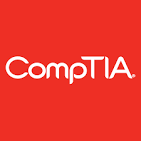Our Security+ Certification Prep Course provides the basic knowledge needed to plan, implement, and maintain information security in a vendor-neutral format. This includes risk management, host and network security, authentication and access control systems, cryptography, and organizational security. This course maps to the CompTIA Security+ certification exam (SY0-601). Our Classroom and Classroom Live courses utilize official CompTIA courseware and labs. Objective coverage is marked throughout the course.
CompTIA Security+ Certification (CompTIA Security+ Certification)

Schedule
- T87841
- 5 days
- 12/15/2025 - 12/19/2025
- 9:00 AM
- (GMT -06:00) Central Standard Time
- Presented via WebEx
- VC
Virtual Classroom
Attend any of our instructor-led classes virtually regardless of your physical location.
- VC
- PC
Private Class
Privately train a group of your employees at your facility, virtually, or any of our locations.
- PC
- LCLive Classroom
Live Classroom
Learn and interact with your instructor and peers in-person in our classrooms. - VCVirtual Classroom
Virtual Classroom
Attend any of our instructor-led classes virtually regardless of your physical location. - PCPrivate Class
Private Class
Privately train a group of your employees at your facility, virtually, or any of our locations. - GTRGuaranteed to Run
Guaranteed to Run
GTR classes are guaranteed to run as promised and delivered.
Course Summary
Show All
Description
Objectives
In the Security+ Certification Prep Course, you will learn to:
- Proactively implement sound security protocols to mitigate security risks
- Quickly respond to security issues
- Retroactively identify where security breaches may have occurred
- Design a network, on-site or in the cloud, with security in mind
Prerequisites
This course assumes basic knowledge of using and maintaining individual workstations.
Attendees should be CompTIA A+ certified (or have equivalent experience) and CompTIA Network+ certified (or have equivalent experience) with 2-3 years networking experience.
Who Should Attend
- Network Administrators
- Cybersecurity Associates
- IT personnel interested in pursuing a career in cybersecurity
Outline
Lesson 1: Comparing Security Roles and Controls
- Topic 1A: Compare and Contrast Information Security Roles
- Topic 1B: Compare and Contrast Security Control and Framework Types
Lesson 2: Explaining Threat Actors and Threat Intelligence
- Topic 2A: Explain Threat Actor Types and Attack Vectors
Lesson 3: Performing Security Assessments
- Topic 3A: Assess Organizational Security with Network Reconnaissance Tools
- Topic 3B: Explain Security Concerns with General Vulnerability Types
- Topic 3C: Summarize Vulnerability Scanning Techniques
- Topic 3D: Explain Penetration Testing Concepts
Lesson 4: Identifying Social Engineering and Malware
- Topic 4A: Compare and Contrast Social Engineering Techniques
- Topic 4B: Analyze Indicators of Malware-Based Attacks
Lesson 5: Summarizing Basic Cryptographic Concepts
- Topic 5A: Compare and Contrast Cryptographic Ciphers
- Topic 5B: Summarize Cryptographic Modes of Operation
- Topic 5C: Summarize Cryptographic Use Cases and Weaknesses
- Topic 5D: Summarize Other Cryptographic Technologies
Lesson 6: Implementing Public Key Infrastructure
- Topic 6A: Implement Certificates and Certificate Authorities
- Topic 6B: Implement PKI Management
Lesson 7: Implementing Authentication Controls
- Topic 7A: Summarize Authentication Design Concepts
- Topic 7B: Implement Knowledge-Based Authentication
- Topic 7C: Implement Authentication Technologies
- Topic 7D: Summarize Biometrics Authentication Concepts
Lesson 8: Implementing Identity and Account Management Controls
- Topic 8A: Implement Identity and Account Types
- Exam objectives covered:
- Topic 8B: Implement Account Policies
- Topic 8C: Implement Authorization Solutions
- Topic 8D: Explain the Importance of Personnel Policies
Lesson 9: Implementing Secure Network Designs
- Topic 9A: Implement Secure Network Designs
- Topic 9B: Implement Secure Switching and Routing
- Topic 9C: Implement Secure Wireless Infrastructure
- Topic 9D: Implement Load Balancers
Lesson 10: Implementing Network Security Appliances
- Topic 10A: Implement Firewalls and Proxy Servers
- Topic 10B: Implement Network Security Monitoring
- Topic 10C: Summarize the Use of SIEM
Lesson 11: Implementing Secure Network Protocols
- Topic 11A: Implement Secure Network Operations Protocols
- Topic 11B: Implement Secure Application Protocols
- Topic 11C: Implement Secure Remote Access Protocols
Lesson 12: Implementing Host Security Solutions
- Topic 12A: Implement Secure Firmware
- Topic 12B: Implement Endpoint Security
- Topic 12C: Explain Embedded System Security Implications
Lesson 13: Implementing Secure Mobile Solutions
- Topic 13A: Implement Mobile Device Management
- Topic 13B: Implement Secure Mobile Device Connections
Lesson 14: Summarizing Secure Application Concepts
- Topic 14A: Analyze Indicators of Application Attacks
- Topic 14B: Analyze Indicators of Web Application Attacks
- Topic 14C: Summarize Secure Coding Practices
- Topic 14D: Implement Secure Script Environments
- Topic 14E: Summarize Deployment and Automation Concepts
Lesson 15: Implementing Secure Cloud Solutions
- Topic 15A: Summarize Secure Cloud and Virtualization Services
- Topic 15B: Apply Cloud Security Solutions
- Topic 15C: Summarize Infrastructure as Code Concepts
Lesson 16: Explaining Data Privacy and Protection Concepts
- Topic 16A: Explain Privacy and Data Sensitivity Concepts
- Topic 16B: Explain Privacy and Data Protection Controls
Lesson 17: Performing Incident Response
- Topic 17A: Summarize Incident Response Procedures
- Topic 17B: Utilize Appropriate Data Sources for Incident Response
- Topic 17C: Apply Mitigation Controls
Lesson 18: Explaining Digital Forensics
- Topic 18A: Explain Key Aspects of Digital Forensics Documentation
- Topic 18B: Explain Key Aspects of Digital Forensics Evidence Acquisition
Lesson 19: Summarizing Risk Management Concepts
- Topic 19A: Explain Risk Management Processes and Concepts
Lesson 20: Implementing Cybersecurity Resilience
- Topic 20A: Implement Redundancy Strategies
- Topic 20B: Implement Backup Strategies
- Topic 20C: Implement Cybersecurity Resiliency Strategies
Lesson 21: Explaining Physical Security
- Topic 21A: Explain the Importance of Physical Site Security Controls
- Topic 21B: Explain the Importance of Physical Host Security Controls